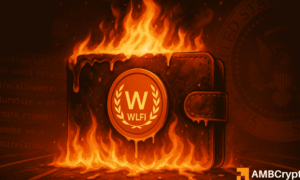World Liberty Financial’s Swift Response to Security Breach: A Lesson in Risk Management
In a recent development, World Liberty Financial (WLFI) took decisive action to safeguard its community after an alarming breach. The company burned 166.667 million WLFI tokens, valued at $22.14 million, from compromised wallets. This move was essential for reallocating the tokens to secure addresses, ensuring that users could recover their assets while maintaining the integrity of the platform. By implementing this emergency function, WLFI showcased its commitment to user security and operational reliability.
Addressing Compromise: Token Recovery and Reallocation
The token burn and reallocation process stemmed from two major factors: unauthorized access to certain wallets and the need to protect the interests of all users. An analysis of blockchain data from Arkham revealed that the World Liberty Fi Deployer address had executed two transactions transferring compromised tokens to a Strategic Reserve address. The entire initiative emphasizes the importance of having robust mechanisms in place for unforeseen circumstances, demonstrating WLFI’s proactive approach to asset recovery.
KYC Verification: Importance and Implications
For users who have yet to complete the Know Your Customer (KYC) verification, the situation is more complicated. Their wallets remain frozen due to security protocols designed to prevent further exploitation. However, WLFI encourages these users to start the recovery process through its dedicated help center. This emphasis highlights the necessity of KYC as a vital component of secure cryptocurrency transactions, ensuring that only verified users can access and utilize their funds effectively.
Prevention Strategy: Phishing Attacks and User Awareness
The breach was primarily attributed to phishing attacks and compromised seed phrases stemming from third-party security lapses, rather than weaknesses within WLFI’s own infrastructure. This revelation serves as a crucial reminder to users to remain vigilant and proactive about their online security. By educating users about the significant risks associated with leaving wallets unprotected, WLFI aims to minimize similar incidents in the future, fortifying its community against external threats.
Built-In Emergency Functions: A Smart Contract Necessity
The ability of WLFI to respond effectively to this incident was enhanced by the built-in emergency functions within its smart contract architecture. These functions were incorporated from the very beginning, enabling the reclaiming of tokens from compromised addresses and redistributing them securely to verified users. WLFI’s proactive strategy in designing its token structure not only mitigates risks but also reinforces user confidence in the platform’s operational capabilities.
Regulatory Scrutiny and Operational Credibility
Backed by the Trump family, WLFI has faced close examination regarding its token structure and regulatory positioning. This recent incident serves as a test for the project’s operational credibility under scrutiny. Successfully navigating this security challenge could bolster WLFI’s standing in the cryptocurrency market, positioning it as a trustworthy platform amidst rising concerns over security and regulatory compliance. The steps taken to recover compromised assets will likely play a crucial role in shaping the project’s future trajectory.
Conclusion: Trust and Security in Cryptocurrency
As the cryptocurrency landscape evolves, the importance of robust security measures and quick, effective responses to threats cannot be overstated. World Liberty Financial’s recent actions highlight the necessity of preparedness and adaptability in safeguarding user interests. By implementing a structured recovery process and emphasizing the need for KYC verification, WLFI not only underscores the significance of community trust but also sets a precedent for other platforms in the industry. In an era marked by volatility and risks, the approach taken by WLFI serves as a crucial lesson in risk management and user protection.



